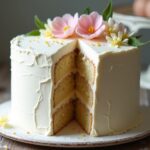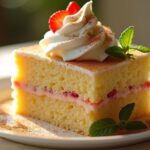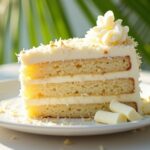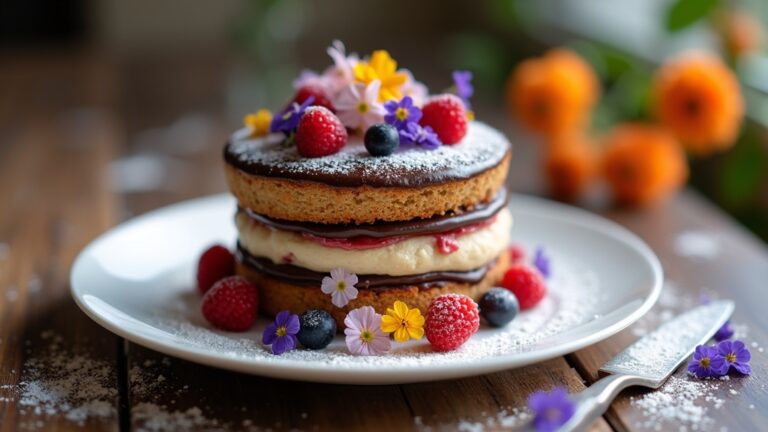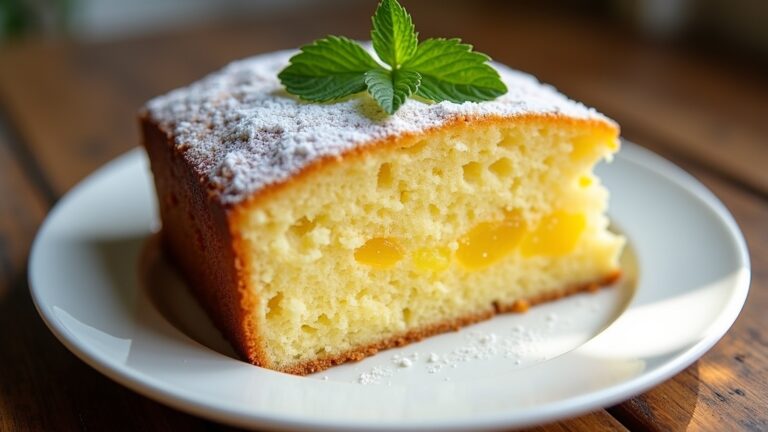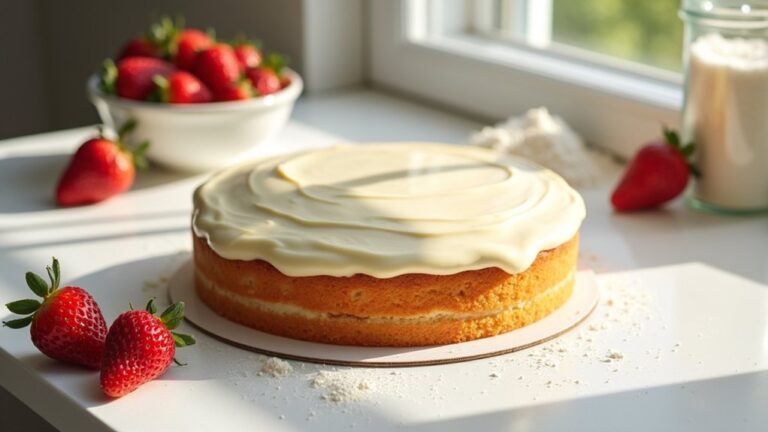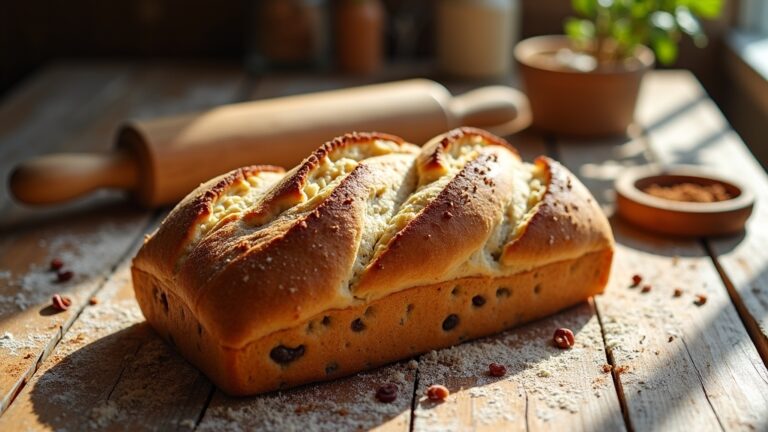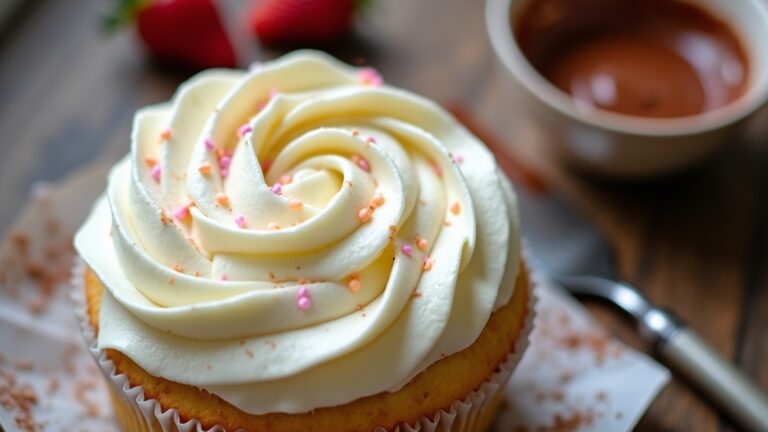Vanilla Cake Recipe
To create a delicious vanilla cake, mix 2 cups flour, 1 ½ cups sugar, ½ cup softened butter, and 1 cup milk. Add 3 ½ teaspoons baking powder for that perfect rise. Preheat your oven to 350°F (175°C). Gently fold your ingredients together and bake for 25-30 minutes. The result? A light, fluffy cake with a sweet vanilla aroma. Want to enhance your baking skills and explore frosting options and variations? There’s so much more waiting for you!
Contents
History
When you plunge into the history of vanilla cake, you’ll discover a delightful evolution that reflects changing tastes and techniques. The cake’s origins trace back to ancient civilizations, where simple mixtures of flour, sugar, and eggs laid the groundwork for what we savor today. As time progressed, innovations like baking powder transformed the texture and rise of cakes, allowing for airy delights. Vanilla, derived from exotic orchids, became a prized flavor, enhancing cakes with its sweet aroma. You’ll notice flavor variations emerging globally, from rich chocolate-infused recipes to fruity twists, each reflecting local ingredients and preferences. This rich tapestry of history shows how vanilla cake has adapted, celebrating both tradition and creativity in every bite.
Recipe
Vanilla cake is a delightful and versatile dessert that is perfect for any occasion, whether it’s a birthday, wedding, or just a simple family gathering. Its light and fluffy texture, combined with a sweet vanilla flavor, makes it a favorite among cake lovers. This classic recipe is easy to follow, ensuring that even novice bakers can achieve a delicious and visually appealing cake.
To make the perfect vanilla cake, it’s essential to use quality ingredients and follow the instructions carefully. The key to a moist and flavorful cake lies in the balance of wet and dry ingredients, as well as the proper mixing technique. Once you master this basic vanilla cake recipe, you can easily customize it with your favorite frostings, fillings, or toppings to make it your own.
Master the art of vanilla cake by using quality ingredients and perfecting your mixing technique for endless customization options.
Ingredients:
- 2 cups all-purpose flour
- 1 ½ cups granulated sugar
- ½ cup unsalted butter, softened
- 1 cup milk
- 3 ½ teaspoons baking powder
- 1 teaspoon vanilla extract
- ½ teaspoon salt
- 3 large eggs
To prepare the vanilla cake, preheat your oven to 350°F (175°C) and grease and flour two 9-inch round cake pans. In a large mixing bowl, cream together the softened butter and sugar until light and fluffy. Add the eggs one at a time, mixing well after each addition. Stir in the vanilla extract. In a separate bowl, combine the flour, baking powder, and salt. Gradually add the dry ingredients to the wet mixture, alternating with the milk, and mix until just combined. Divide the batter evenly between the prepared pans and bake for 25-30 minutes or until a toothpick inserted in the center comes out clean. Allow the cakes to cool in the pans for 10 minutes before transferring to wire racks to cool completely.
For best results, allow your cake to cool completely before frosting it, as this will prevent the frosting from melting. If you’re looking to take your vanilla cake to the next level, consider adding a simple syrup to keep the layers moist or incorporating different flavor extracts like almond or lemon for a unique twist. Additionally, always use room temperature ingredients for better emulsification, and be cautious not to over-mix the batter, as this can result in a dense cake. Happy baking!
Cooking Steps
To get started on your vanilla cake, preheat your oven to 350°F, ensuring it’s ready to create that perfect rise. Next, mix your dry ingredients together in a bowl, creating a balanced blend that’ll support the cake’s fluffy texture. Then, gradually add your wet ingredients, stirring gently to form a smooth batter that’s ready to bake to golden perfection.
Step 1. Preheat Your Oven
Preheating your oven is an essential step that sets the stage for a perfectly baked vanilla cake. Start by adjusting the oven temperature to 350°F (175°C), which is ideal for this cake. While the oven warms up, grab your baking tools—an oven thermometer can guarantee accuracy, as some ovens misread temperatures. It’s vital to give your oven enough time to reach the desired heat before you place your cake inside. A properly preheated oven promotes even baking, helping your cake rise beautifully and develop a golden crust. If you want freedom in your baking journey, this step can’t be skipped; it’s the foundation for achieving that light, fluffy texture you crave. So, let the warmth build!
Step 2. Mix Dry Ingredients Together
Start by gathering three key dry ingredients: all-purpose flour, baking powder, and salt. The dry ingredient importance in your vanilla cake can’t be overstated; they create the structure and flavor foundation. In a large bowl, sift the flour, making sure any lumps vanish. This mixing technique aerates the flour, promoting a lighter cake. Next, add the baking powder and salt. Whisk these ingredients together until evenly combined; this step guarantees that the leavening agent is distributed uniformly, preventing any uneven rising. You want a seamless blend, so use a gentle, circular motion to mix. Once you’ve achieved a fine, homogeneous mixture, you’re ready to move on. Trust that these dry elements are the unsung heroes of your cake’s success!
Step 3. Add Wet Ingredients Gradually
As you prepare to add the wet ingredients, confirm you have everything measured and ready to go, since this step is essential for achieving the right batter consistency. Start by combining your wet ingredient ratios, like eggs, milk, and vanilla extract, in a separate bowl. This confirms uniformity before they mingle with the dry mix. Begin pouring the wet mixture into the dry ingredients, but do it gradually. This gradual mixing allows for better absorption, preventing any lumps from forming. Use a whisk or spatula to blend them until just combined. Remember, overmixing can lead to a dense cake, so stop as soon as you see a cohesive batter. Embrace the rhythm of creation; your perfect vanilla cake is taking shape!
Step 4. Fold in the Batter
Once you’ve combined your wet and dry ingredients into a cohesive batter, it’s time to fold in the mixture with care. Using a spatula, scoop from the bottom of the bowl and lift the batter over itself. This gentle motion preserves the air you’ve incorporated, which is essential for achieving a light, fluffy cake texture. Avoid vigorous stirring, as that can deflate the batter and compromise its rise. Continue this folding technique until you see no dry flour remnants. Remember, the goal is to maintain the batter’s airy quality while ensuring everything is evenly blended. Mastering these baking techniques now will set the stage for a perfect vanilla cake that delights with every bite!
Step 5. Bake for 30 Minutes
With your batter perfectly folded, it’s time to bake your creation for 30 minutes. Preheat your oven to 350°F (175°C) if you haven’t already. Grease your cake pan using a baking technique that guarantees easy release: a light dusting of flour over the greased surface works wonders. Pour in the batter, smoothing the top for even baking. As it bakes, the aroma will fill your kitchen, teasing your senses. Keep an eye on the clock; every oven varies slightly, so check for doneness by inserting a toothpick in the center—if it comes out clean, you’re golden! This foundation opens the door to countless cake variations, from chocolate to lemon zest, waiting for your creative touch. Enjoy the magic!
Nutritional Guide
Understanding the nutritional aspects of your vanilla cake not only helps you enjoy it guilt-free but also allows you to make informed choices for you and your loved ones. Here’s a breakdown of the caloric content and ingredient benefits that can elevate your dessert experience:
| Ingredient | Caloric Content (per slice) |
|---|---|
| All-purpose flour | 100 calories |
| Sugar | 50 calories |
| Butter | 80 calories |
| Eggs | 70 calories |
Each ingredient contributes unique benefits: flour provides energy, sugar adds sweetness and mood-lifting properties, butter enhances flavor while offering healthy fats, and eggs contribute protein and nutrition. By understanding these elements, you can savor your cake with freedom and joy, balancing indulgence with wellness.
Final Thoughts
As you reflect on your homemade vanilla cake, remember that each slice represents more than just a dessert; it’s a blend of flavors, textures, and the joy of baking. You’ve got the freedom to explore countless cake variations, from adding zesty lemon zest to incorporating rich chocolate chips or nuts. Each tweak can transform your creation into something uniquely yours.
Don’t forget about the frosting options, either! A classic buttercream can elevate your cake, while a light whipped cream or tangy cream cheese frosting can add a delightful twist. Whether you opt for a simple glaze or a lavish decoration, the choice is yours. Embrace your creativity, and let your vanilla cake be a canvas for endless possibilities. Happy baking!
Frequently Asked Questions
Can I Substitute Butter for Oil in the Recipe?
You can substitute butter for oil, but expect texture differences. Butter adds richness and a denser crumb, while oil yields a moister, lighter cake. Choose based on your desired outcome and flavor preference. Enjoy experimenting!
How Do I Store Leftover Vanilla Cake?
To store leftover cake, wrap it tightly in plastic wrap or foil. This method preserves cake freshness, preventing it from drying out. Alternatively, use an airtight container for ideal cake storage and enjoy your treat longer!
Can I Freeze Vanilla Cake for Later Use?
Yes, you can freeze vanilla cake for later use! Use proper freezing techniques, like wrapping it tightly in plastic wrap and aluminum foil. Follow storage tips to maintain its moisture and flavor for future enjoyment.
What Frosting Pairs Best With Vanilla Cake?
For a delightful pairing, consider rich chocolate ganache for a luscious contrast or tangy cream cheese frosting for a creamy balance. Both options elevate your cake, offering unique flavors that celebrate your culinary creativity.
How Can I Make a Gluten-Free Version?
Did you know that nearly 1 in 100 people have celiac disease? To create a gluten-free version, experiment with gluten-free flours like almond or coconut, and remember these baking tips to guarantee successful results.
Conclusion
As you savor that slice of vanilla cake, remember that this delightful dessert has been a staple in homes for centuries, bringing joy to countless celebrations. Did you know that nearly 80% of people associate cake with happy memories? Each bite not only satisfies your sweet tooth but also connects you to moments of laughter and love. So, indulge in your creation, share it with loved ones, and let the sweetness of vanilla cake brighten your day!
